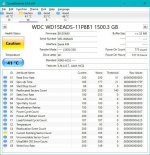ubuysa
The BSOD Doctor
I keep a fairly regular check on the SMART data on my drives to try and predict failures ahead of time. A couple of days ago I came across something unusual which I thought might be worth sharing to see whether any SMART people (see what I did there?) might know more than I about what might be going on.
The drive in question is a 3.5" 1.5TB HDD that I've had for probably close on 8 years (at a guess). It used to be an external drive but has been an internal drive in my PCS PC for the last 12 months. I use it as a media drive but there's nothing on there that isn't also in at least two other places. CrystalDiskInfo shows a caution for this drive because of the Current Pending Sector Count Value.

Current Pending Sector Count is a measure of how unstable the drive has become and is one of the key indicators of drive health. These sectors (and I appear to currently have 6) have apparently become unstable and need to be remapped into the reserved sectors. They are apparently 'pending' until they are next read, a successful read should decrease the Current Pending Sector Count (and presumably a failed read should trigger a remapping?).
According to the SMART data no sectors have yet been remapped, the Reallocated Sectors Count is zero (the normalised worst value is 200), and interestingly the Read Error Count is also zero (the normalised worst value is 200), which is bizarre if I have 6 'flaky' sectors? However, the Write Error Count has been positive in the past (the worst normalised value is 149) and the Uncorrectable Sector Count has also been positive in the past (the worst normalised value is 198) but for an old drive I don't see those as a particular problem? But for the CrystalDiskInfo Caution indicator I don't see anything of major concern with this drive, especially given its age?
Still concerned I ran a wmic /namespace:\\root\wmi path MSStorageDriver_FailurePredictStatus command at the Command Prompt, it reported all drives as 'OK' and a System Diagnostics run via the Performance Monitor reported no disk errors either.
My first instinct was to run a chkdsk /r on the drive, which I did. It found no errors at all. Still not happy I did a full (ie. not quick) format of the drive, this zeroes every sector and thus tests the drive surface to some degree. It formatted cleanly. Still not entirely happy I ran the Ccleaner drive wipe over the whole drive using 7 passes (yes it did take a couple of days!). That reported no errors.
At no time did the Current Pending Sector Count change and yet the drive appears to be working normally.
I'm not one for taking chances so a new HDD to replace this one is already on order, but I'm still curious to understand why the Current Pending Sector Count stubbornly remains at 6 no matter what I do to the drive?
The drive in question is a 3.5" 1.5TB HDD that I've had for probably close on 8 years (at a guess). It used to be an external drive but has been an internal drive in my PCS PC for the last 12 months. I use it as a media drive but there's nothing on there that isn't also in at least two other places. CrystalDiskInfo shows a caution for this drive because of the Current Pending Sector Count Value.

Current Pending Sector Count is a measure of how unstable the drive has become and is one of the key indicators of drive health. These sectors (and I appear to currently have 6) have apparently become unstable and need to be remapped into the reserved sectors. They are apparently 'pending' until they are next read, a successful read should decrease the Current Pending Sector Count (and presumably a failed read should trigger a remapping?).
According to the SMART data no sectors have yet been remapped, the Reallocated Sectors Count is zero (the normalised worst value is 200), and interestingly the Read Error Count is also zero (the normalised worst value is 200), which is bizarre if I have 6 'flaky' sectors? However, the Write Error Count has been positive in the past (the worst normalised value is 149) and the Uncorrectable Sector Count has also been positive in the past (the worst normalised value is 198) but for an old drive I don't see those as a particular problem? But for the CrystalDiskInfo Caution indicator I don't see anything of major concern with this drive, especially given its age?
Still concerned I ran a wmic /namespace:\\root\wmi path MSStorageDriver_FailurePredictStatus command at the Command Prompt, it reported all drives as 'OK' and a System Diagnostics run via the Performance Monitor reported no disk errors either.
My first instinct was to run a chkdsk /r on the drive, which I did. It found no errors at all. Still not happy I did a full (ie. not quick) format of the drive, this zeroes every sector and thus tests the drive surface to some degree. It formatted cleanly. Still not entirely happy I ran the Ccleaner drive wipe over the whole drive using 7 passes (yes it did take a couple of days!). That reported no errors.
At no time did the Current Pending Sector Count change and yet the drive appears to be working normally.
I'm not one for taking chances so a new HDD to replace this one is already on order, but I'm still curious to understand why the Current Pending Sector Count stubbornly remains at 6 no matter what I do to the drive?
